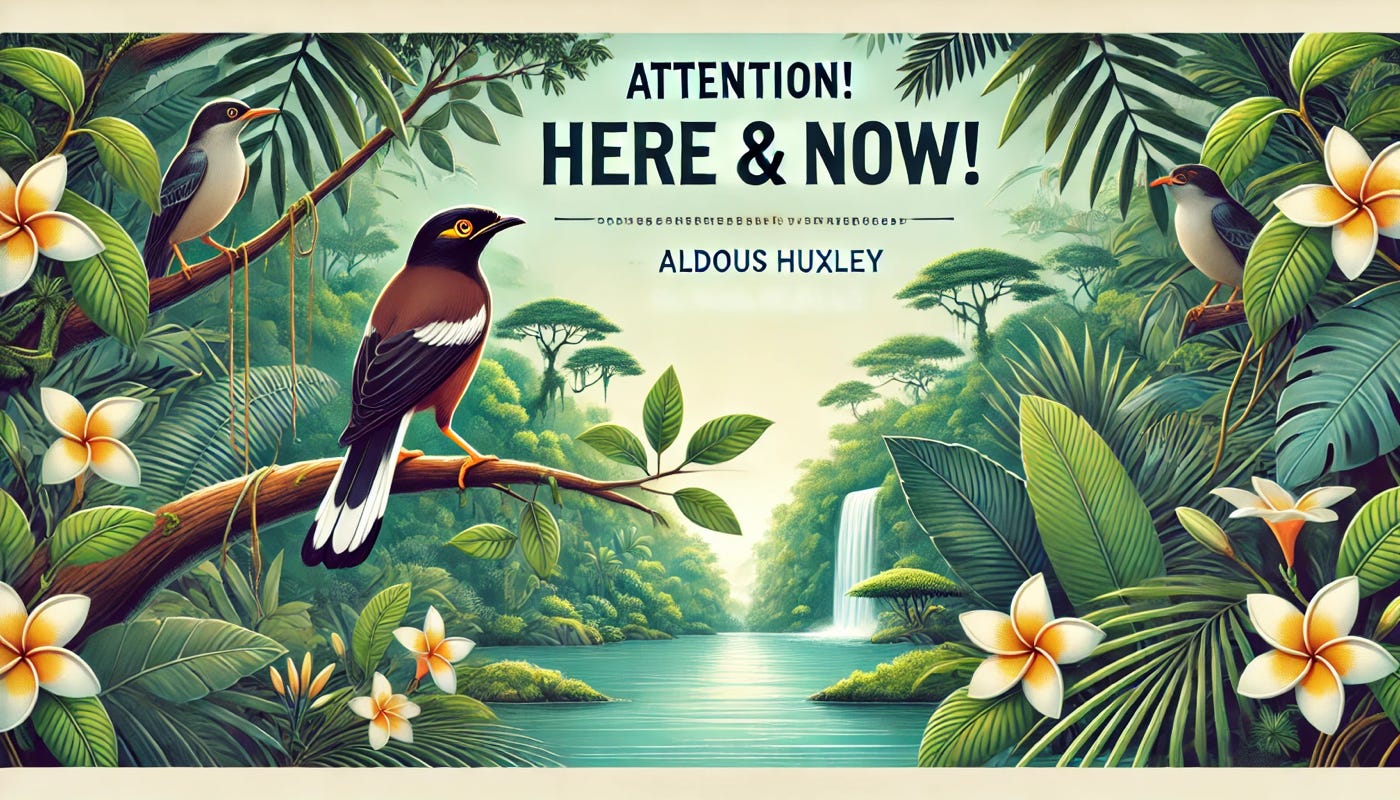In Aldous Huxley’s novel Island, the utopian society of Pala trains mynah birds to recite phrases like “Here and now” as gentle reminders for inhabitants to return to the present moment. These birds, flitting through the verdant landscapes, symbolize the community’s commitment to mindfulness and presence. The Palanese understand that true peace and harmony arise when individuals fully engage with the present, free from the distractions of past regrets and future anxieties.
In our rapidly evolving world, characterized by technological advancements and constant connectivity, the wisdom of Pala’s mynah birds resonates more than ever. We are surrounded by devices and platforms that promise connection yet often leave us feeling more disconnected—from ourselves, from others, and from the essence of life itself. The present moment—the Here and Now—is the overlooked solution that can bridge this gap, overcoming bias and prejudice, and synthesizing our technological progress with personal development rooted in love.
The Overlooked Power of the Present Moment
Despite the myriad ways we can connect digitally, many of us find ourselves caught in cycles of distraction, perpetually pulled away from the present. We dwell on past mistakes or fixate on future ambitions, seldom immersing ourselves in the richness of the Here and Now. Yet, it is only in the present moment that life unfolds, that experiences are truly felt, and that authentic connections are made.
Mindfulness—the practice of bringing one’s full attention to the present moment—has been lauded for its profound impact on mental health and well-being. Studies have shown that regular mindfulness practice can reduce stress, enhance emotional regulation, and improve interpersonal relationships. By grounding ourselves in the present, we become more attuned to our thoughts and feelings without becoming overwhelmed by them.
Overcoming Bias and Prejudice Through Presence
Biases and prejudices are often rooted in past experiences and conditioned beliefs. They cloud our judgment and hinder our ability to see others clearly. When we operate on autopilot, these unconscious biases guide our interactions, leading to misunderstandings and divisions.
By embracing the Here and Now, we create space to observe our thoughts and reactions as they arise. This awareness allows us to recognize biased thinking patterns and choose responses aligned with empathy and understanding. In Pala, the mynah birds’ calls to “Attention” serve as prompts for individuals to return to this state of mindful awareness, fostering a society where people relate to each other without the veils of prejudice.
Synthesizing Technological Advancement and Human Connection
Our era is marked by unprecedented technological growth. Artificial intelligence, personal robots, and instant access to global information hold the promise of solving complex problems and improving quality of life. However, without mindful integration, these advancements can exacerbate feelings of isolation and detachment.
To create a harmonious synthesis between technology and human development, we must approach innovation with intention. This means designing and using technology in ways that enhance our capacity for presence rather than detract from it. For example, apps that promote mindfulness and well-being, virtual reality experiences that foster empathy, or communication platforms that encourage meaningful interactions can bridge the gap between technological progress and our intrinsic need for connection.
Lessons from Pala’s Downfall
In Island, despite the Palanese commitment to mindfulness and communal well-being, their utopia ultimately succumbs to external forces driven by greed and exploitation. The lure of oil reserves beneath Pala’s surface attracts those who prioritize profit over people, leading to the society’s undoing.
This narrative serves as a cautionary tale for our times. It highlights the vulnerability of even the most enlightened communities when confronted with unchecked greed and materialism. To prevent a similar fate, we must cultivate not only individual mindfulness but also collective ethical frameworks that prioritize the well-being of all over the interests of a few.
The Universal Experience of Oneness and Love
When we are fully present, the boundaries that separate us from others begin to dissolve. We tap into a sense of oneness—a recognition that, at our core, we are interconnected. This realization fosters unconditional love and compassion, extending beyond personal relationships to encompass all of humanity and the natural world.
Practices that anchor us in the Here and Now, such as meditation, mindful movement, or simply observing our surroundings with curiosity, open us to this profound experience. By nurturing this connection, we lay the groundwork for a society that values empathy, kindness, and mutual respect.
Embracing the Here and Now in the Modern World
The challenges we face today—social division, environmental degradation, ethical dilemmas posed by technological advancement—require solutions that are both innovative and deeply human. By returning to the present moment, we equip ourselves with the clarity and openness needed to address these issues thoughtfully.
• Personal Practices: Incorporate moments of mindfulness into daily routines. Simple acts like mindful breathing, savoring a meal without distractions, or taking a walk in nature can ground us in the present.
• Mindful Technology Use: Set intentions for how and when to engage with technology. Use devices as tools for growth and connection rather than sources of constant distraction.
• Community Engagement: Foster communities that value presence and authentic connection. This could involve group meditation sessions, discussions about mindful living, or collaborative projects that benefit society.
A Vision for a Harmonious Future
Imagine a world where individuals are attuned to the present moment, where technology serves as a bridge rather than a barrier, and where societies prioritize the well-being of all over the wealth of a few. In such a world, biases diminish, relationships deepen, and collective actions reflect a shared commitment to harmony and love.
This vision is not a distant utopia but a tangible possibility. It begins with each of us choosing to heed the call of the mynah bird: to pay attention, to be here and now. By doing so, we contribute to a ripple effect that can transform our lives and, by extension, the world around us.
Conclusion: Answering the Call of the Mynah Bird
The simple message of Pala’s mynah birds carries profound wisdom. “Here and now” is both a reminder and an invitation—to step out of the mental chatter that often consumes us and into the fullness of the present moment. It is in this space that we find peace within ourselves and sow the seeds for a more harmonious world.
As we navigate the complexities of modern life, let us remember the power of presence. Let us approach each moment with curiosity and openness, recognizing that it holds the potential for growth, connection, and transformation. By embracing the Here and Now, we align ourselves with the timeless flow of life, where love is both the path and the destination.
Take a moment now to pause. Close your eyes if you feel comfortable doing so. Take a deep breath in, and a slow breath out. Listen to the sounds around you. Feel the sensations in your body. This is the Here and Now—the ever-present backdrop of your life. May you carry this awareness with you, and may it guide you toward peace and harmony.














Share this post